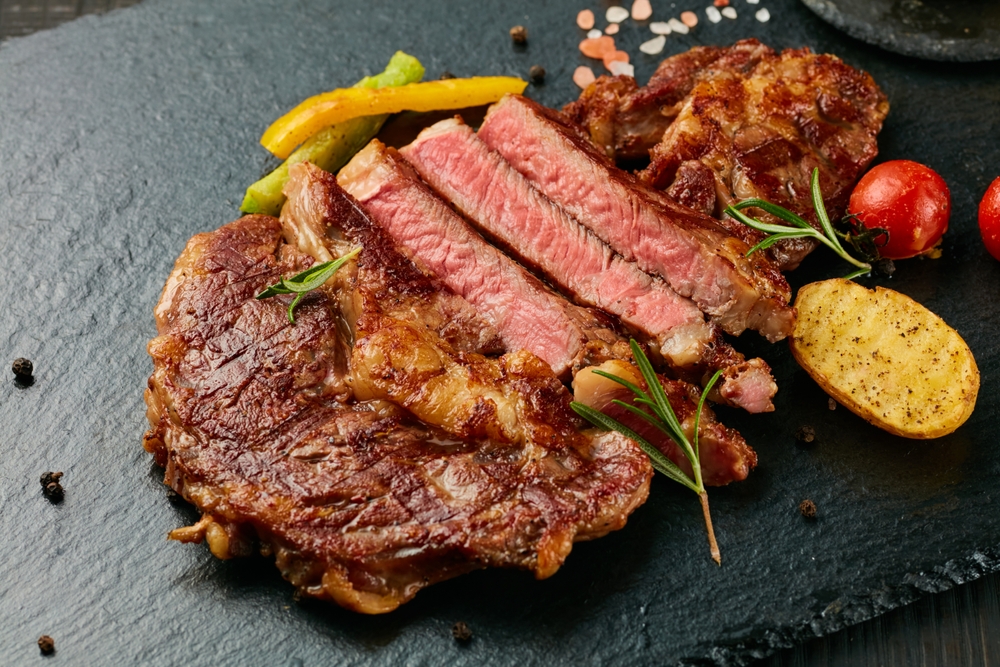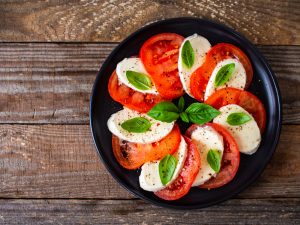Chicken breast is better for weight loss than steak because it delivers more protein per calorie—165 calories and 31 grams of protein per 100 grams versus 183-291 calories and 22-29 grams of protein in steak depending on the cut.
That said, lean cuts of steak can absolutely work in your weight loss plan when you control portions properly, and the full picture involves factors like iron content, satiety, cost, and how you prepare each meat—so keep reading for the complete breakdown.
Calorie and Protein Showdown: The Numbers That Matter
When you compare these proteins side by side, the difference becomes clear immediately.
Skinless chicken breast delivers 165 calories per 100 grams with 31 grams of protein and just 3.6 grams of fat.
That translates to roughly 80% of calories coming from protein and only 20% from fat—an impressive ratio for anyone tracking macros.
Steak tells a different story depending on what you order:
- Lean sirloin: 183-210 calories per 100g with 22-29g protein and 8-13g fat
- Ribeye: 240-291 calories per 100g with 23g protein and 22g fat
Look at a typical 4-ounce serving and the gap widens.
You'll consume approximately 185 calories with chicken breast versus anywhere from 207 to 330 calories for steak, with ribeye hitting the high end.
Here's what this means for your daily eating: if you eat protein three times per day, choosing chicken over fattier cuts saves you 100-400 calories daily without reducing your protein intake.
Over a week, that's 700-2,800 calories—nearly a pound of fat loss from protein choice alone.
When you're in a calorie deficit, you want maximum protein to preserve muscle while minimizing overall calories.
Chicken gives you more protein per calorie than any cut of beef, which means you can eat larger portions while staying within your targets.
How Protein Affects Your Hunger and Fat Loss
Both chicken and steak deliver complete protein containing all essential amino acids your body needs.
Where they really shine, though, is in how they affect your metabolism and appetite.
Protein has a thermic effect of 20-30%, meaning your body burns that percentage of protein calories just processing the food itself.
Compare this to carbohydrates at 5-10% and fats at a mere 0-3%. Every time you eat chicken or steak, you're automatically burning more calories through digestion than you would with most other foods.
The hunger control aspect is even more powerful. High-protein meals trigger your body to release satiety hormones like peptide YY and GLP-1 while simultaneously reducing ghrelin—the hormone that makes you feel hungry.
Research shows this hormonal shift can reduce your calorie intake at the next meal by up to 20% without you even trying.
From a pure satiety standpoint, both proteins perform equally well. Where chicken pulls ahead is in portion size.
Since it packs more protein into fewer calories, you can eat a larger piece of chicken than steak for the same calorie budget.
That extra volume on your plate translates to feeling fuller and more satisfied while maintaining your calorie deficit—which is exactly what you need for consistent weight loss.
The Cut You Choose Changes Everything
Not all chicken and steak are created equal. The specific cut you buy can swing your calorie intake by hundreds per serving.
For chicken, skinless breast is non-negotiable if you're serious about weight loss. Leaving the skin on adds 102 calories per serving and shifts the fat content from 20% to 39% of total calories.
Dark meat like thighs and drumsticks ranges from 144-214 calories per 100 grams compared to breast's lean 106 calories.
The breast wins calorie control every time.
For steak, your cut selection creates even more dramatic differences:
- Best lean options: Sirloin (176-210 cal/100g), flank steak (160 cal/100g), top round
- Avoid for weight loss: Ribeye (240-291 cal/100g), T-bone (450 cal for a typical serving)
That fat marbling in premium cuts adds incredible flavor, but it also loads up the calorie count.
Trimming visible fat from any steak can significantly reduce what you're consuming.
Here's the insight most people miss: choosing the right cut matters just as much as choosing between chicken and steak.
A lean sirloin versus chicken breast is actually a close comparison—both hover around 180-210 calories per serving.
Ribeye versus chicken breast? That's not even the same conversation.
Cut selection gives you direct control over your calorie budget without sacrificing protein intake.
Make this choice deliberately every time you shop.
Why Micronutrients Matter for Your Results

Steak dominates the iron conversation.
Beef contains 2.4-2.7 milligrams of iron per 100 grams compared to chicken's 0.7-0.9 milligrams.
But the real advantage goes deeper than raw numbers.
Between 62-77% of beef's iron is heme iron—the highly absorbable form found in meat.
Chicken contains about 74% heme iron, but with so much less total iron, it still falls short.
Heme iron absorbs at rates of 15-35% while non-heme iron from plants absorbs at only 2-20%.
When you do the math, steak delivers roughly 3-4 times more absorbable iron than chicken.
This matters more than you might think. Iron deficiency can slow your metabolism and increase fatigue—two things that make weight loss considerably harder.
Steak also provides significantly more vitamin B12, zinc, and selenium, while chicken offers more niacin (vitamin B3).
Both deliver B vitamins that keep your metabolism running efficiently.
Prioritize steak if you're:
- A menstruating woman with higher iron needs
- Diagnosed with iron deficiency
- Training intensely and depleting iron stores faster
For most people focused on weight loss, though, these micronutrient differences shouldn't override calorie considerations.
You can supplement iron or add iron-rich plant foods alongside chicken.
The smartest approach?
Rotate between both proteins throughout the week to cover nutritional gaps without compromising your calorie targets.
Portion Sizes and Cooking Methods That Make or Break Progress
The recommended serving size for any meat is 3-4 ounces cooked—roughly the size of a deck of cards or what fits in your palm.
Here's what that looks like in practice:
- Chicken breast: 140-185 calories, 26-31g protein
- Lean sirloin: 160-210 calories, 23-29g protein
- Ribeye: 240-300 calories, 20-23g protein
Aim for three protein servings daily, spaced throughout your meals.
This spacing maximizes satiety and helps preserve muscle mass while you're in a calorie deficit—both non-negotiable for successful weight loss.
Your cooking method can sabotage even the smartest protein choice.
Grilling, baking, broiling, or poaching add virtually no calories.
Pan-frying with butter or oil, breading, or drowning your meat in heavy sauces?
That's where things go sideways.
Fried chicken packs 50+ extra calories per serving compared to grilled—enough to stall your progress over time.
Here's a measurement trick most people get wrong: meat loses about 25% of its weight during cooking as water evaporates, but the protein and calories stay exactly the same.
A 4-ounce raw chicken breast shrinks to roughly 3 ounces cooked, yet still contains those same 31 grams of protein.
If you're eyeballing portions, either weigh your meat raw or account for this cooking loss.
Otherwise, you'll consistently underestimate what you're actually eating.
The Smart Strategy: When to Choose Each
Your protein choice shouldn't be all-or-nothing. Each has distinct advantages depending on your situation.
Choose chicken breast when you:
- Want maximum weight loss with the lowest calories and highest protein density
- Need precise calorie control to hit specific daily targets
- Are working within a budget—chicken costs around $11 per kilogram versus $40+ for quality beef
- Prefer eating larger protein portions without blowing your calorie budget
- Do meal prep in bulk, since chicken maintains quality better when stored
- Need a protein you can eat 4-5 days weekly without getting tired of it
Choose lean steak when you:
- Need more dietary iron, particularly if you're a menstruating woman
- Can manage portions carefully without the temptation to overeat
- Want variety to prevent diet fatigue and keep meals interesting
- Have less concern about cost in your food budget
- Need the additional vitamin B12, zinc, and selenium that beef provides
- Want something more satisfying for occasional meals
The smartest approach combines both strategically.
Use chicken breast as your primary protein source 4-5 days per week for consistent calorie control.
Then incorporate lean steak 2-3 times weekly for micronutrient diversity and meal satisfaction.
This strategy gives you chicken's weight loss efficiency alongside beef's nutritional benefits, prevents diet monotony, and lets you enjoy steak without derailing your progress.
You're not sacrificing results—you're optimizing for both adherence and nutrition.
Conclusion
Chicken breast objectively wins for weight loss thanks to its superior calorie-to-protein ratio, but lean cuts of steak absolutely fit into a successful plan when you control portions properly.
The most important factors are preparing either protein without added fats, sticking to 3-4 ounce servings, and maintaining your overall calorie deficit.
Your best results come from choosing whichever protein you'll actually eat consistently while following these guidelines—because adherence beats perfection every time.







